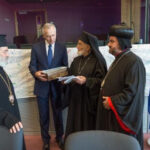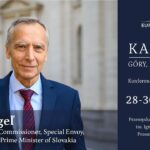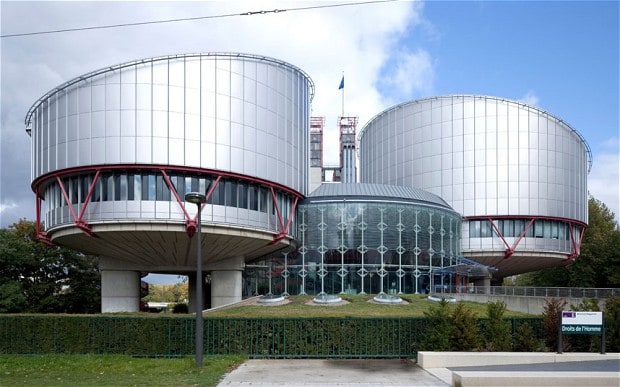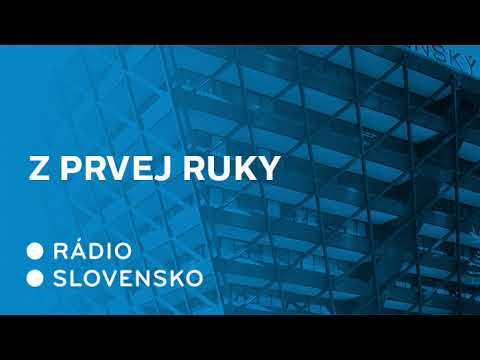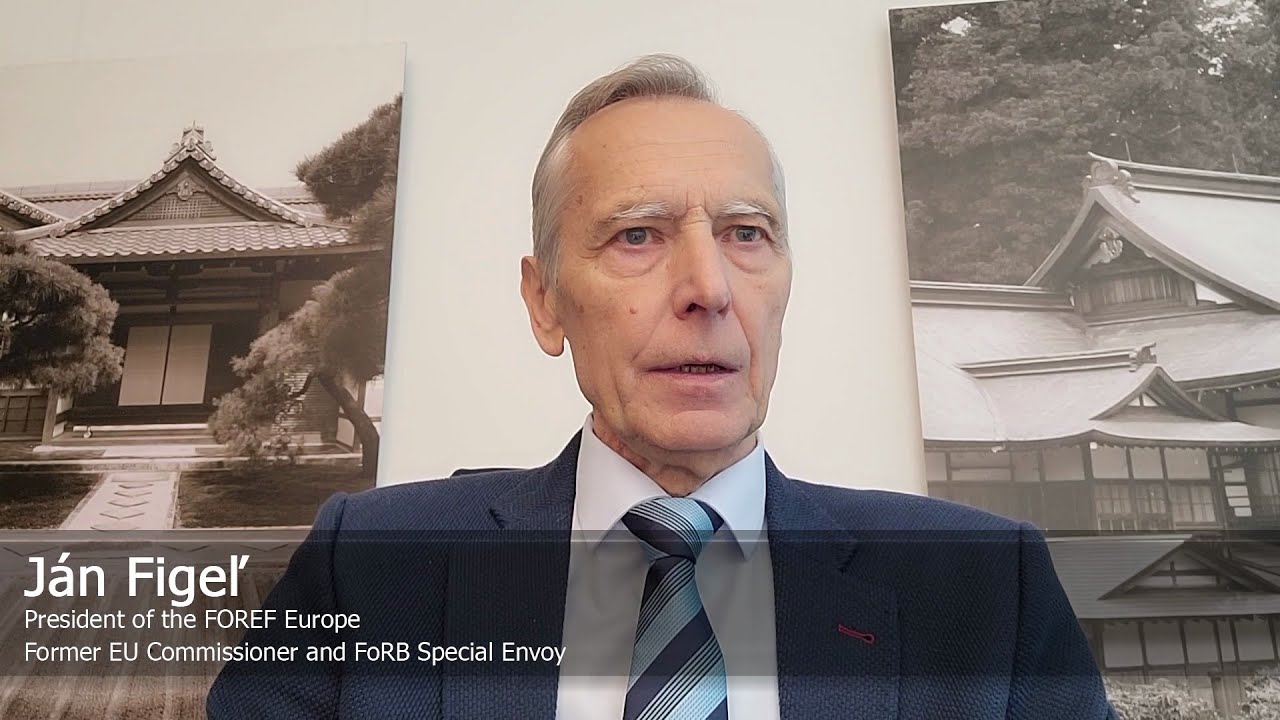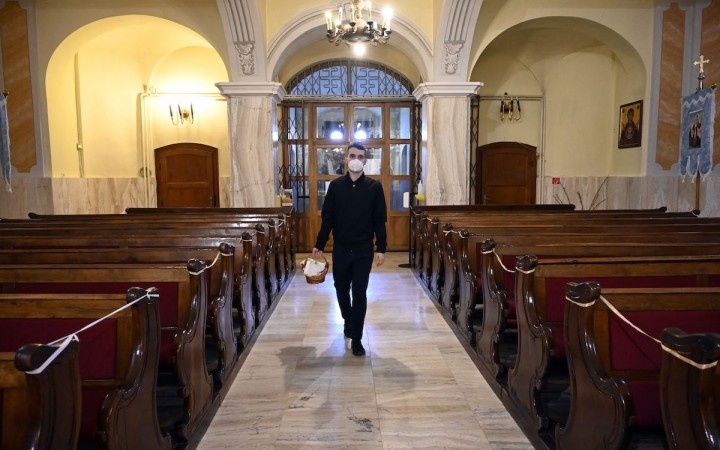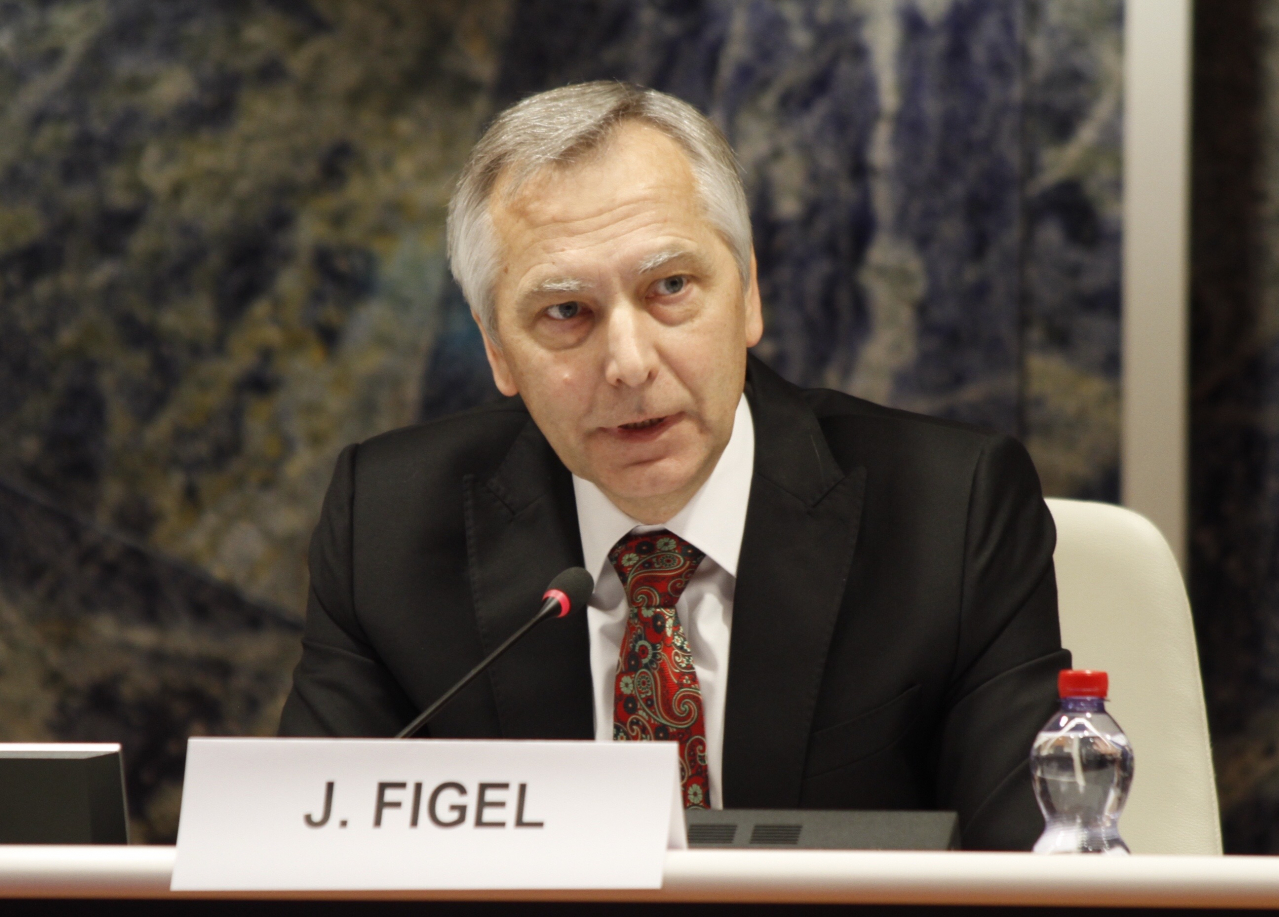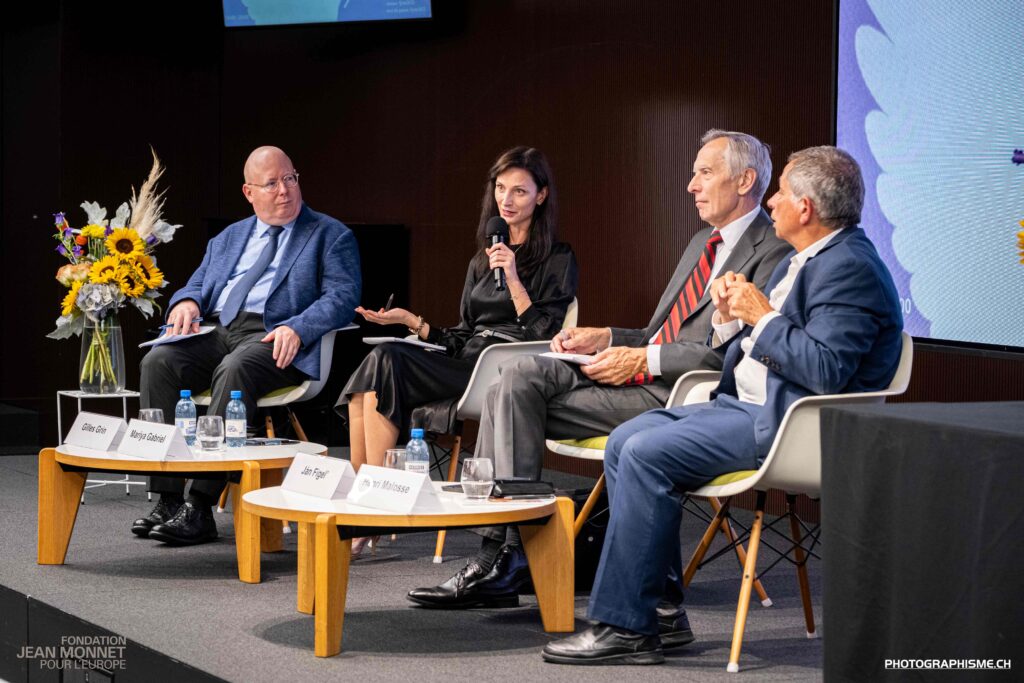
Lausanne, September 8, 2025.
On September 8, 2025, the Jean Monnet Foundation for Europe, in partnership with the Jean Monnet Association, hosted a public dialogue at the University of Lausanne entitled “How to Build a Sustainable Peace in Europe?”
Two former members of the European Commission participated in the discussion: Ján Figel’, President of the Scientific Committee of the Clementy Schuman Legacy Foundation, former European Commissioner, and former Deputy Prime Minister of Slovakia; and Mariya Gabriel, President of the Robert Schuman Institute (Budapest), former European Commissioner and former Deputy Prime Minister of Bulgaria.
The session was opened and moderated by Gilles Grin, Director of the Jean Monnet Foundation for Europe; Henri Malosse, Chair of the Advisory Board of the Jean Monnet Association, former President of the European Economic and Social Committee; and Olivier Védrine, Board Member of the Jean Monnet Association, journalist and professor.
From the outset, the discussion was placed within its historical context. Gilles Grin recalled a text written by Jean Monnet in Algiers in 1953, which laid out the original ambition of European integration: to transform inter-state rivalries into structured interdependence, specially designed to prevent the recurrence of war on the continent. In the same breath, he described the war waged by Russia as imperialist, establishing sovereignty and aggression as the central lens through which the debate would unfold.

Henri Malosse then cited a phrase attributed to Jean Monnet, “We unite not states, but people,” to underscore the “societal” orientation of the European project. He noted that the Jean Monnet Association had traveled to Kyiv to explain the principles of European integration and to advocate for the opening of accession negotiations with Ukraine. He further argued that, in the early stages of the war, European leaders had failed to assert their positions sufficient strength. These reminders placed the discussion within the historical continuum of Monnet’s legacy, while firmly anchoring it in the present security context.

The points put forward by Ján Figel’
The first keynote address was delivered by Ján Figel’. He began with a personal biographical reference, recalling the assassination of his uncle by the KGB in Czechoslovakia, noting that some personal histories had “paid the highest price” to make possible a space in which to speak about the future of peace. This preamble led to a definition: peace, in his view, is not simply the absence of war, but the very condition for the exercise of human dignity. He pointed out that 136 constitutions worldwide explicitly refer to dignity, and that Europe has gradually embedded this principle into its legal and political frameworks., from the Council of Europe in 1949 to today’s European Union. From this perspective, he presented the EU as a soft power actor: one that operates through law, norms, standards, and predictability, rather than through direct coercion.
Building on this foundation, Figel’ outlined three main areas of action. First, enhancing the European Union’s economic and technological attractiveness, with innovation and competitiveness described as prerequisites for long-term stability. Second, consolidating a European defense framework within existing legal instruments, particularly the Treaty of Lisbon, with an emphasis on interoperability and cooperation among Member States. Third, expanding cooperation, including with groupings such as the BRICS, through a strategy of selective engagement designed to avoid lasting isolation and to better manage interdependence. These three dimensions (economy, defense, and cooperative diplomacy) were presented as complementary facets of a single stabilization strategy.

Regarding the chronology of the conflict, Figel’ proposed a structured interpretation. He considers what he calls a “second Cold War” to have begun in February 2014, when, in his view, Europe’s security balance first began to shift in systemic terms. Looking ahead, he referred to the idea of a “second Schuman Plan”: echoing the original use of the common market as a tool of pacification, the aim would be to activate economic and institutional mechanisms to organize de-escalation and reconstruction. The roadmap he presented for ending the war was sequenced as follows: ceasefire, peace treaty, reconstruction, the right of return for displaced persons and refugees, international recognition of the settlement to avoid isolating the parties, respect for the self-determination of affected populations, and the gradual lifting of economic sanctions, conditioned on the effective implementation of commitments, in order to release resources for reconstruction. The timeframe mentioned for international normalization ranged from seven to ten years, with no operational details provided concerning guarantors or monitoring mechanisms.
The orientations presented by Mariya Gabriel
Mariya Gabriel followed, structuring her remarks around another maxim attributed to Jean Monnet: “Nothing is possible without people, nothing is possible without institutions.” She described the European Union as an “exception” due to its unique political and legal architecture, emphasizing that this singularity only has meaning if it extends outward and fosters cooperation with neighbouring region.
She argued that the present moment should be understood as a pivotal phase. Since the invasion of Ukraine, enlargement has, in her view, become a tool in the service of peace. She noted that the number of candidate countries has increased over the past three years and defended the principle of gradual integration: opening access in stages to parts of the internal market and to certain EU programs before full membership, in exchange for verifiable progress, particularly in the fight against corruption and more broadly in strengthening the rule of law. The objective, as she framed it, is to deliver tangible benefits and create incentives for closer alignment, while preserving the Union’s governance standards.

In this context, Gabriel described the European defense industry as an integral part of the single market. She stressed that certain dependencies on third countries could be turned into strategic tools during periods of tension, highlighting the need to embed defense capabilities more firmly within Europe’s economic framework.
She also presented trade policy as a lever for stability. Mercosur was cited as an example of an agreement that could help diversify supply chains and establish shared standards. Two cross-cutting elements completed the picture: innovation, presented as a driver of resilience and competitiveness; and fake news, characterized as a force multiplier that shapes the conduct of war and undermines social cohesion, thus requiring robust responses in the information domain. This emphasis on innovation and digital resilience reflected her previous experience as European Commissioner for the Digital Economy and Society.
Questions, issues and an emerging method
The Q&A session brought out several perspectives. One participant raised the idea of a potential “fourth major historical turning point,” marked by a shift of power from West to East and the possibility of Europe’s implosion. The responses did not endorse this view; instead, they used it to restate a set of priorities: in the East, ensuring the security of Poland and the Baltic states, and on the international stage, the need, according to Mariya Gabriel, for a more inclusive United Nations Security Council, so that the Global South is more directly involved in decisions on peace and security. Ján Figel’ in turn emphasized that while anti-Americanism exists in many parts of the world, anti-European sentiment is mostly expressed within Europe itself. He highlighted the importance of recognizing national and European identities as compatible and complementary within a common project.
Over the course of the evening, what emerged was less a slogan than a method. On one side, Figel’ outlined a structured sequence for ending the war: a ceasefire, a peace treaty, reconstruction, the return of displaced persons, international recognition of a settlement, the conditional lifting of sanctions, and a seven-to-ten-year horizon, with markets and institutions presented as the tools to sustain this process.
On the other, Gabriel stressed the connection between people and institutions, the importance of gradual enlargement with conditionality, the integration of the defense industry into the single market, the use of a trade policy as a stabilizing force, and the inclusion of information management and innovation as central variables in peace policy. Both approaches converged on the need for verifiable steps, clear criteria, and regular evaluation rather than proclaiming a single definitive solution.

Moreover, through the constant presence of Monnet in the background, the discussion was anchored in the European integration tradition: building peace through institutions, rules, procedures, and interdependence. Henri Malosse linked this framework to the concrete initiatives of the Jean Monnet Association, such as its trip to Kyiv and its advocacy for opening accession negotiations, while noting that, in his view, Europe’s positions in the early stages of the conflict had lacked clarity.
The notion of “sustainable peace” was thus unpacked layer by layer. In the way it was used, it did not refer to an indefinite suspension of hostilities, but rather to an institutionalized process: a set of incentives (gradual access to the single market, programs, funding), conditions (rule of law, anti-corruption efforts); capabilities (defense, energy, digital); standards (industrial norms, competition rules, oversight mechanisms); and guarantees (international recognition, monitoring arrangements). Trade was presented as a stabilizing tool, through diversification and predictability; enlargement as a step-by-step path rather than a final act; the defense industry as a sector of the single market; innovation as an amplifier of resilience; and information as a theater of operations in its own right. Within this framework, international governance requires more inclusive formats, according to Mariya Gabriel, particularly at the UN Security Council.
Some questions were left open. The timetable and criteria for lifting sanctions were not specified, whether in terms of benchmarks, guarantors, or conditions. The parameters of gradual integration, such sectoral scope, thresholds for compliance, or early access to certain EU policies, were likewise not quantified. Cooperation with groupings such as the BRICS was mentioned only in general terms, without concrete domains being identified. Combating disinformation was deemed essential, but no detail was provided as to which instruments should take priority, whether media literacy, regulation, partnerships with platforms or detection capabilities. Finally, the idea of a more inclusive United Nations Security Council was not accompanied by a specific institutional model. These gaps did not reflect omissions so much as the very nature of a public dialogue: the purpose was not to settle technical details but to outline directions and methods.
Overall, the discussions converged around several shared points. Civilian and military instruments must be brought together: economy, law, innovation, defense, and diplomacy all form part of the same architecture. Enlargement, far from being only the endpoint of a process, can be mobilized as a tool along the way through phased approaches and conditionality. The defense industry was presented as a strategic sector closely tied to Europe’s industrial policy. Finally, the information domain was recognized as a security issue in its own right, comparable to energy or digital policy, given its impact on social cohesion and political legitimacy.
Security on Europe’s eastern flank emerged as a recurring theme, with Poland and the Baltic states cited as front-line territories. In this context, the measures discussed, such as defense cooperation, interoperability, industrial capacity, support for Ukraine, gradual integration, and trade policy, were presented as complementary levers. Their prominence reflects a common conviction: that European peace, if it is to be durable, cannot rest on a single instrument but must rely on a web of tools combining economy, institutions, defense, and information. Yet this vision must now be tested against new kinds of threats, ones that no longer manifest only in trenches or diplomatic negotiations but also in the aerial and digital domains. The recent drone attacks serve as a stark reminder that Europe’s vulnerabilities are being redrawn, and that the very meaning of “building a sustainable peace” requires rethinking.
Towards a Sustainable Peace in an Uncertain Sky
Lausanne provided the setting for a dialogue that, by repeatedly invoking the legacy of Jean Monnet, sought to remind us that peace in Europe is never a given but rather a fragile and progressive construction. Yet the events of recent days, the massive incursion of Russian drones into Poland, which triggered NATO alert mechanisms, and the coordinated attack on Copenhagen Airport, described by Danish authorities as the most serious strike ever against critical national infrastructure, demand a new reading of what it means to “build a sustainable peace.”
These attacks reveal that European security can no longer be conceived solely in terms of land borders or conventional battles. The threat now moves through the air, through digital networks, through information itself: diffuse, ubiquitous, and asymmetric. In other words, Europe is no longer confronted with a war “at its doorstep” but with one that penetrates its vital spaces. Peace, therefore, cannot be reduced to the suspension of military hostilities; it becomes the capacity to absorb shocks, to prevent disorder, and to rebuild in the moment.

It is precisely here that Jean Monnet’s legacy regains an unexpected relevance. As early as the 1950s, Monnet understood that peace cannot simply be declared; it must be institutionalized through organized interdependence, through rules and procedures that structure daily life. Transposed into the present, this means that European peace can only be secured if we succeed in weaving, beyond armies, a dense network of cooperation: in the defense industry, in technological innovation, in energy resilience, and in the governance of the information space.
The drones over Warsaw and Copenhagen are a stark reminder that European integration is no longer played out only in treaties or in the corridors of Brussels, but in the ability to mount a common response to unprecedented forms of vulnerability. Where Figel’ sketched a sequence for ending the war based on verifiable steps, and Gabriel argued for gradual enlargement anchored in conditionality, a shared imperative emerges: to make Europe an area of predictability, capable not only of building balances but also of resisting their disruption.
Thus, sustainable peace in Europe can never be a fixed state. It must become a dynamic method, blending law, economy, defense, innovation, and inclusive governance, able to adapt to shifting threats. Just as the common market once embodied integration, today it must expand into new domains, digital, technological, and security-related, to turn vulnerability into solidarity.
The drones remind us that war can erupt in the sky above an airport as easily as on a front line. To remain faithful to its founding project, Europe must respond not by erecting walls, but by inventing networks of trust, shared procedures, and new interdependencies. In this sense, peace is not the distant horizon of a final victory but the continent’s daily capacity to transform threat into connection, instability into cooperation, and vulnerability into strength.
Gwendoline Munsch

